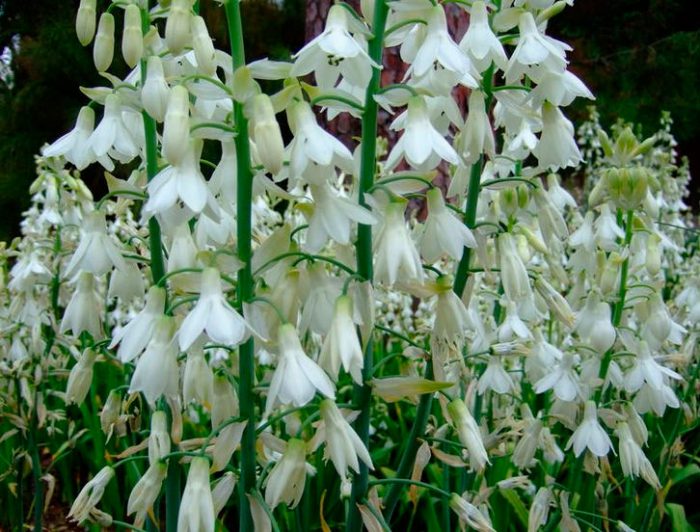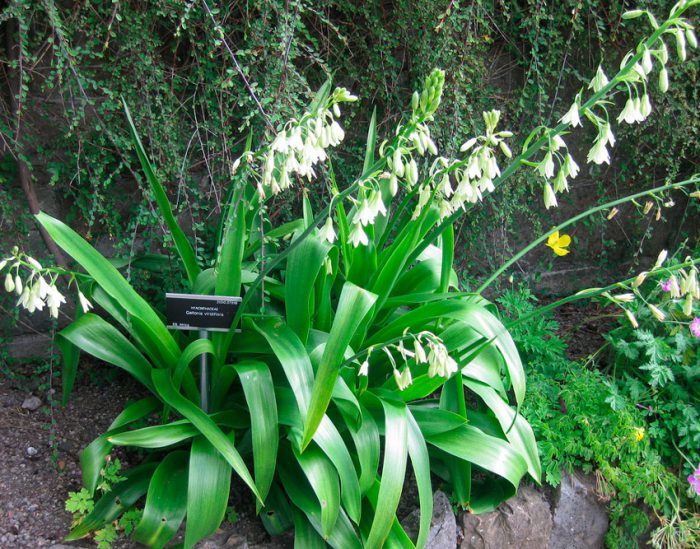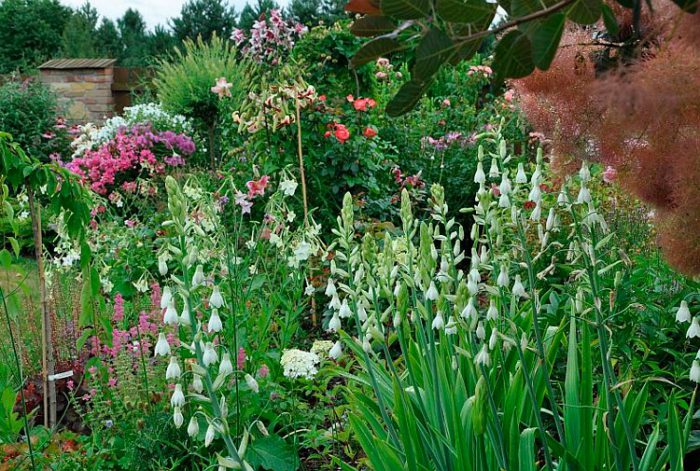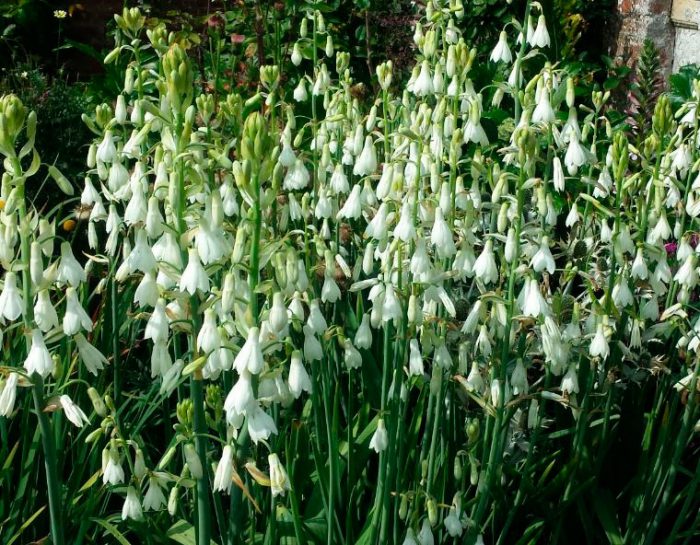Bulbous perennial plant Galtonia, also called Cape hyacinth, is a member of the lily family. The homeland of such a plant is the Cape of Good Hope. Galtonia was named after the English explorer of the flora of South Africa Francis Galton. In Europe, this flower has been grown as a late flowering plant since the seventies of the 19th century. In nature, there are 4 types of galtonia, however, gardeners mainly grow only 1 - the galtonia is whitish or whitish.
Content
Features of galtonia
The height of the galtonium can vary from 0.5 to 1.5 m. Large conical bulbs have a concave bottom. Leaf plates are bare, juicy, grooved, belly-shaped. The height of the peduncle is about 100 centimeters, it bears a loose racemose inflorescence, consisting of drooping white flowers, which have a non-falling tubular-funnel-shaped perianth. Flowering occurs in August and September. The fruit is a slightly ribbed three-nested cylindrical box. Inside the capsule is a large number of seeds of irregular triangular shape and black color.
Planting galtonia in open ground
What time to plant
In order for galtonia to grow and develop normally in the garden, it is necessary to focus on the natural conditions that are familiar to it. So, in the winter time in the Caspian mountains it is cold and dry, and in the summer it is humid and warm. In this regard, for planting this plant, you should find a site where there will be no stagnation of melt water in the spring. If possible, plant Galtonia on a sunny rocky slope located in the southern part of the garden. This flower can be grown both in a well-lit and shaded area. The soil is light, slightly acidic, well-drained, deeply processed, and humus must be added to it.
Planting galtonia should be done in spring only after the soil warms up well (from the last days of March to May). You can control the flowering time of this plant if you wish. For this, the bulbs can be planted a little earlier or later. And also the flowering time is influenced by how much the bulb will be buried in the soil.
How to plant correctly
When choosing planting material in the store, carefully examine it. Remember that the bottom should be free of mold, rot, or signs of softening. As for the bulb, it must be firm and firm.
Before planting the bulbs, they can be grown up, in this case, the galtonia will bloom 4 weeks earlier. To do this, in April, the bulbs must be placed in a warm and well-lit room. First, they are treated with a fungicide solution, and then laid out in a very well-lit place, but do not forget to protect the planting material from direct sunlight. When the sprouts appear, the bulbs will need to be planted in pots, which should have holes for drainage. For planting, use loose garden soil. Do not forget to water the planted bulbs from time to time. Planting such bulbs in open soil should be done in May, while the plants should be planted with a lump of earth.
The depth to which the bulb should be planted depends on its size (large bulbs are planted deeper), and it can vary from 18 to 22 centimeters. A distance of 0.3 meters should be kept between bushes in a row. In the event that drainage was not laid under the top layer of soil, then one handful of coarse sand should be poured into each hole immediately before planting. Also, do not forget to add complex mineral fertilizer to it. If during the digging no organic matter was introduced into the soil, then one handful of compost or humus will also need to be added to each hole.
The planted plants need abundant watering.
Galtonia care in the garden
Despite the fact that Galtonia is an exotic plant native to the African continent, when grown in mid-latitudes, caring for it is quite simple. It, like most other garden plants, will need to be watered, weeded, fed in a timely manner and do not forget to loosen the soil surface. During the period of active growth, such a plant must be provided with abundant watering, 24 hours after it, it is necessary to loosen the soil, simultaneously pulling out all the weeds. During the flowering period, watering should be less abundant.
Throughout the growing season, Galtonia needs to be fed only 1 or 2 times and for this, mineral fertilizer is used for flowering plants. In some cases, tall peduncles need a garter to support. When all the flowers wither, the peduncle should be cut off so that it does not take away the strength from the bulb.
In the same place, such a flower can be grown for 4 or 5 years, while it forms dense thickets.
Diseases and pests
In the event that during planting the plant was provided with good drainage, then this means that it is reliably protected from fungal diseases. If the weather is damp, then galtonias can harm snails and slugs. For preventive purposes, it is recommended to scatter wood ash over the surface of the site. If you still see gastropods on the bushes, then collect them by hand.
After flowering
Galtonia is moderately hardy. Therefore, if you live in a region with rather mild winters, then you do not need to dig up its bulbs for the winter, but they should be covered with a thick (15 to 20 centimeters) layer of peat or sawdust, which should be covered with dried foliage or spruce branches. To prepare Galtonia for winter, choose a dry day.
If, in the region where Galtonia is grown, the winter is frosty or with little snow, then in the last days of October or the first - November, it is imperative to remove the bulbs from the soil. They are dried in a well-ventilated room for 7 days, while the foliage from the bulbs does not need to be cut. When the bulbs are dry, cut the foliage to a height of 20 mm from the bulb neck, the roots cannot be removed. Then the bulbs will need to be dried at room temperature for another 1-1.5 weeks.After that, they are buried in dry sand or peat in such a way that they do not touch each other, and put away in a cool dry (from 10 to 15 degrees) place for storage. In the event that there are few bulbs, they can be stored in the refrigerator by placing them on the vegetable shelf, but it should be noted that they can become damp there.
In the springtime, before planting galtonia in open soil, you can divide the nests of the bulbs.
Types and varieties of galtonia with photos and names
Whitish Galtonia (Galtonia candicans), or Whitish Galtonia (Hyacinthus candicans)
This perennial plant does not exceed 150 centimeters in height. The diameter of the bulbs is about 7 centimeters, they are covered with a large number of dry membranous scales. Basal leaf plates of dark green color are grooved, belt-like and linear, 4–6 of them grow on one bush. The leaves are 0.9 meters long and 8 centimeters wide. Outwardly, they are similar to hyacinth foliage. The racemose inflorescences consist of tubular-funnel-shaped drooping fragrant flowers of white color, the length of which is 60 mm and the diameter is 30 mm. Flowering occurs in August and September. The fruit is a triangular box with seeds.
Galtonia excellent (Galtonia princeps = Hyacinthus princeps)
In nature, this species is found in the subtropical region of South Africa, while it can grow up to 1000 meters above sea level. This plant prefers to grow among forbs. The height of the bush is about 100 centimeters. The diameter of the cone-shaped bulb is 30–40 mm, they are covered with fibrous scales. The short racemose inflorescence contains from 10 to 15 white drooping flowers, which are slightly greenish outside. The flowers reach 35 mm in length. Blooms in September. This species is cultivated relatively rarely.
Green-flowered galtonia (Galtonia viridiflora)
This species is distinguished by its thermophilicity. The bulbs of such a plant in the fall must be removed from the soil, and they are stored for storage in a cool and dry room. You can save the bulbs by planting them in pots. The height of the bush is about 100 centimeters. On each of his shoots there are 10-30 green-emerald flowers. If such galtonia is grown at home, then its peduncles will be lower.


Watch this video on YouTube



















